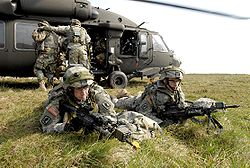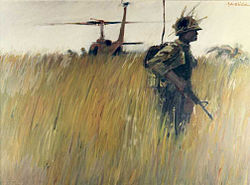Landing zone

In military terminology a landing zone (LZ) is an area where aircraft can land.
In the United States military, a landing zone is the actual point where aircraft, especially helicopters, land (equivalent to the commonwealth landing point.)
In commonwealth militaries, a landing zone is the cartographic (numeric) zone in which the landing is going to take place (e.g., a valley). The landing area is the area in which the landing is going to take place (e.g., the field where the aircraft are to land). The landing point is the actual point on which aircraft are going to land (e.g., a point of the field). Each aircraft has a different landing point.
Identifying an LZ from the air
Landing areas are most commonly marked by colored smoke. The standard procedure is for troops already on the ground at the landing area to "pop smoke" (set off a smoke grenade). The aircraft pilot(s) radio back when the smoke is spotted and what color smoke they see. Troops on the ground then respond with what color the smoke should be. Smoke of a different color can mean that the landing area has been discovered and compromised by the enemy, and the pilot will usually have the authority to cancel any landing.
Vietnam War

The United States used LZs to a greater extent in the Vietnam War than in other wars because of the widespread use of helicopters, which provided increased mobility and rapid transportation of forces. LZs could be temporary, being little more than a clearing in the jungle or a clearing made using special munitions, such as commando vault bombs, which cleared everything in a diameter of 150 feet. Other LZs were permanent or semi-permanent built with more deliberate construction. The Battle of Ia Drang in 1965 centered on two LZs.
Afghanistan

The Soviet Union and Coalition forces also used LZs extensively because of the rugged terrain and distances traveled during wars in Afghanistan.
Temporary LZs
LZs operated by the First Cavalry Division, especially in War Zone C in 1968 and 1969, were often established for specific operations or to draw out the North Vietnamese Army (NVA) units thought to be operating in that area. When a sizable enemy force was located, it could be decisively engaged, forced to move on, or if determined to be elsewhere, the LZ would be abandoned for a new location after a successful mission.
LZ Carolyn was one such LZ; first established as a special forces outpost near Cambodia at Prek Lok in Tay Ninh province, it was abandoned and later occupied by mechanized elements of the 1st Infantry Division. LZ Carolyn was situated in a location especially irritating to the NVA, astride one of the main access routes for the Viet Cong (VC) & NVA to reach Saigon, its presence was a constant problem for them. In April 1969, the US Army's 2/8 Cavalry reopened the LZ and began operations in its vicinity, and the hornet's nest had been prodded. Incoming rocket and mortar rounds fired by the VC/NVA were a daily and nightly occurrence, and skirmishes near the LZ were common. Then on the night of May 6, 1969, an entire NVA regiment (95C) attacked the LZ, which was defended by 300 US Army troops. As described by Tom Lane[permanent dead link]:
The 1st Cav troopers suffered 9 dead and 160 wounded. The NVA's 95C regiment suffered hundreds of dead, many more wounded, and six were captured alive. The LZ was abandoned two weeks later.
Tactical landing zones
Tactical landing zones (abbreviated to TLZ) are landing zones selected on the battlefield for the insertion of troops or supplies. A TLZ can be used for the landing of an aircraft (in terms of the Royal Air Force, this could be a Hercules carrying supplies or troops or any of their other helicopters, such as the Merlin, Puma or the Chinook). A TLZ would be situated in an area safer or easier to defend than the open battlefield, and troops are carefully trained in the insertion process and defensive circles are common.